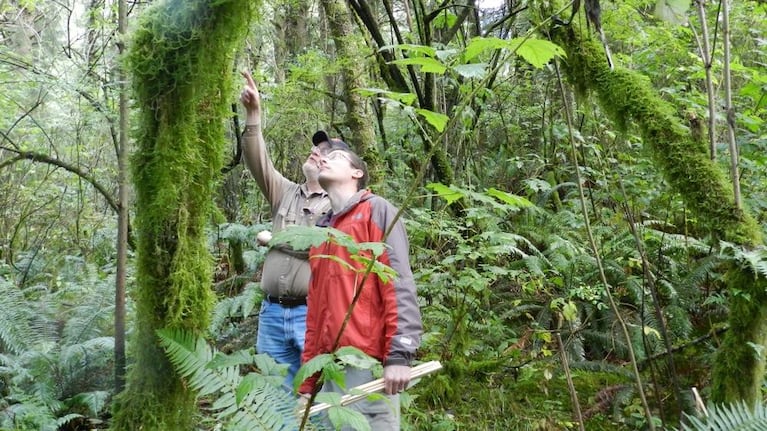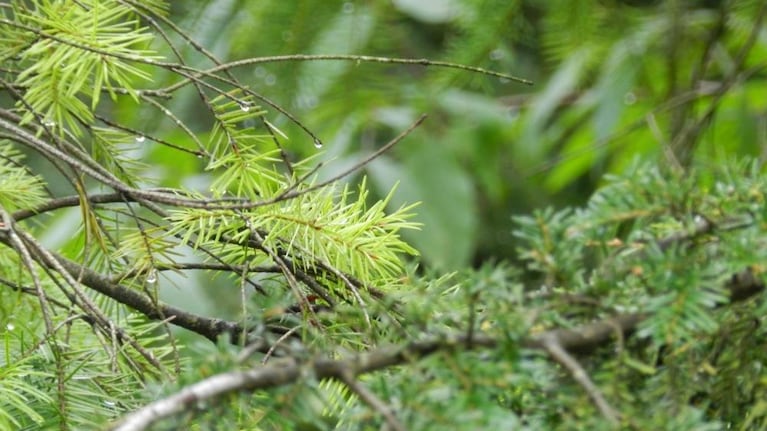
Scientists Jeff Stone and Bryan Black look up at the thin crowns of coastal Douglas fir trees infected with Swiss needle cast just north of Tillamook, Ore.
In 2008, scientist Bryan Black took core samples the diameter of a pencil from a forest near the north Oregon coast. Most of the trees were hemlocks and Douglas fir that had been undisturbed for about 90 years.
The hemlocks were growing normally. But Black was shocked at what he saw in the Douglas fir samples.
"In 1984, these Douglas fir all but shut down," Black says. "In fact, their growth was so slow that it wasn't even forming wood around the whole circumference of the tree."
The firs were so stressed, they couldn't form rings and were laying down wood in patchy strips. The trees' growth between 1984 and 2008 was packed into just a millimeter. The trees had a particularly severe case of Swiss needle cast, a disease caused by a fungus that infects Douglas fir needles and starves the trees of carbon dioxide.
A Douglas fir tree core showing a dramatic slowdown in growth caused by Swiss needle cast infection. Credit: Bryan Black.
Unlike many problem diseases, the fungus that causes Swiss needle cast is native, not an invader; it evolved in the Pacific Northwest. For decades, foresters believed the pathogen didn't cause any disease or symptoms in its native range. Then Douglas firs with thin foliage and yellow needles started to appear on the Oregon coast in the 1970s. Today, a Swiss needle cast epidemic affects about 3 million acres of coastal Douglas fir.
A whole range of variables may have contributed to this sudden outbreak of a native tree disease, but Black's tree ring studies suggest that one of the key factors is winter temperatures that have warmed by about half a degree each decade since the 1960s.
Black and fellow researchers have been trying to understand why the disease appeared relatively suddenly, and what explains the severity of the disease in some coastal Oregon forests and its mildness elsewhere.
"Bryan was able to correlate increases in winter temperature with changes in tree ring width and growth declines," says Jeff Stone, an expert in tree diseases at Oregon State University who is also studying Swiss needle cast.
How the Disease Works
- The disease is caused by a fungus, Phaeocryptopus gaeumanni.
- The fruiting part of the fungus develops in openings in the needle called stomata.
- This clogs the stomata, restricting the needle's intake of CO2 and photosynthesis.
- When 25-50% of the stomata are blocked, the needle becomes an energy sink.
- The tree sheds needles that lose energy. Older, infected needles yellow and die.
- Eventually, the tree struggles to produce sugars and wood and its growth shuts down.
An infected needle with blocked stomata. Credit: Bryan Black.
Stone says early climate modeling work suggests that the area of land impacted by the disease will increase over the next 80 years, though he doesn't yet see indications it will spread out of the Coast Range and into the Cascades.
Neither Black nor Stone say they are alarmed by the rapid spread of Swiss needle cast. Native pathogens play an important role in determining what tree species occupy particular niches. Recent history and forest management practices have led Douglas firs to dominate in many coastal forests.
The spread of Swiss needle cast could allow other native trees to regain their competitive advantage, Black says: "These forests might be replaced by hemlock or Sitka spruce and other species, and return to their historical character."
On parts of the landscape, the disease has already led young hemlocks- normally a slower-growing tree- to crowd out Douglas firs.
For the forest-products industry in coastal Oregon, the spread of the disease could mean significant lost income. Mark Gourley, a forester with Starker Forests in Philomath, says the disease is often hard to detect until a stand is 10 or 15 years old. At that point a company or landowner has already made a significant capitol investment in the trees.
"It has huge economic impacts, when you've got wood out there that's not growing" he said.
In 1996, the Oregon Department of Forestry, the U.S. Forest Service, and private timber owners formed a cooperative. The cooperative pays for a yearly flight up and down the coast to look for yellowing Douglas firs.
"The symptoms that we can visually see are moving inland about two air miles a year," says Gourley. He estimates about a third of Starker's Doug firs are impacted by the disease.
A map from the 2010 aerial survey of Swiss Needle Cast. Credit: Swiss Needle Cast Cooperative and Oregon Department of Forestry.
Gourley works closely with both Black and Stone, but he's not convinced warming winter temperatures are the key variable that's driving the spread of Swiss needle cast. Gourley is focused on other research that suggests that soil composition could affect the severity of the disease. Gourley says he's experimented with hundreds of strategies, from thinning stands to treating the soil with plane loads of phosphorus and calcium. He's hopeful improving soil nutrition will make the trees more resilient.
"It's probably a combination of a bunch of things. We've got probably more Douglas fir out there than we have in the last 100 years. Maybe Jeff's right, we've had warmer temperatures the last several years, ... maybe we're into different genetics with our trees. The nutrition has changed in the soil over time. There's just a whole bunch of factors that have come together," Gourley says.






